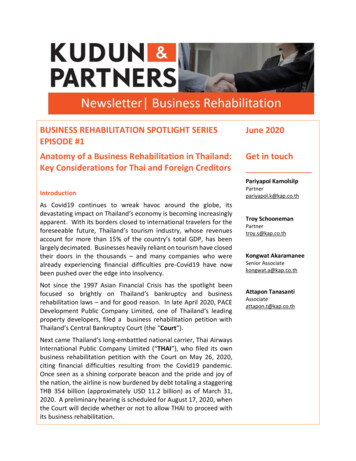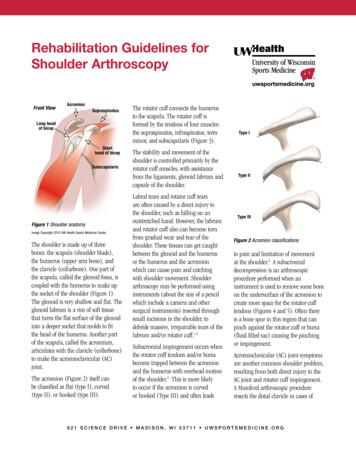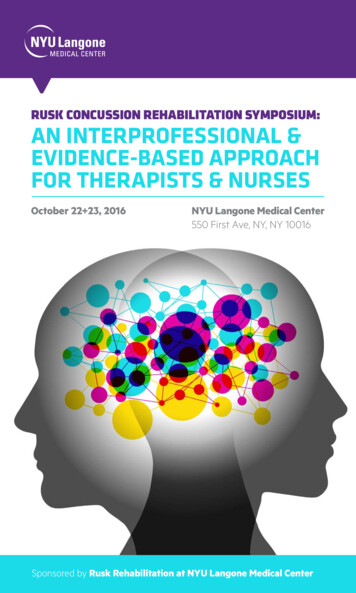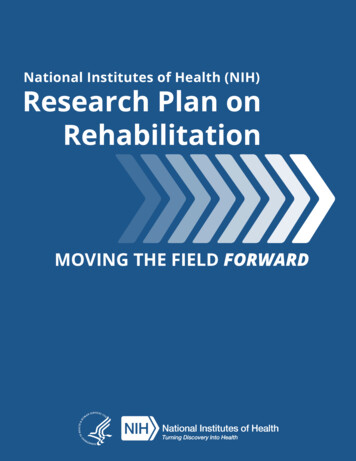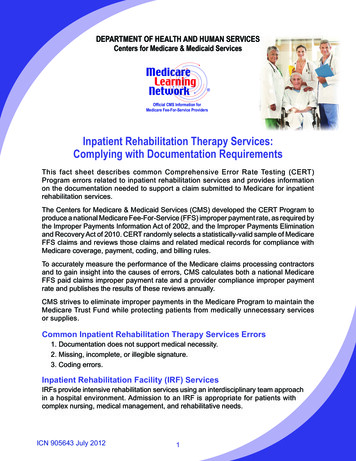
Transcription
Chapter 4Rehabilitation
“Being an amputee myself with functional lower limb prosthetics, I can say that thedevice enable me to function normally. My prosthetics brought back my confidence andself esteem to participate in mainstream activities of the society, thus changing my outlookin life to positive to more positive. Definitely, my prosthetics had an impact on my presentstatus or the quality of life I am enjoying now because I basically perform all the task thatis assigned to me which at the end the day results to quality output and good pay.”Johnny“Coming from a country where there is not much awareness and resources for dealingwith post-spinal cord injured victims, my return home was indeed an enormous challenge. Living in a house that was inaccessible, members of my family have had to persevere with daily lifting me up and down the house. Physiotherapy had become a crucialnecessity and as a result of the continuous costs incurred, my mother took up the task toadminister physiotherapy as well as stand in as my caretaker. During my rehabilitationprocess, getting admitted for treatment during times of illness or to use physiotherapyfacilities was close to impossible as a result of the overwhelming numbers on the waitinglist. My rehabilitation period despite challenging was a humbling moment of my life anda continuous process that I face until today. I have learned disability is not inability and astrong mentality and great attitude have been very important!”Casey“Families find themselves in difficulty after a member of the family has a stroke. Iconsider myself a stroke survivor but my family are stroke victims. I have been fortunateand have been able to return to work, but I have had to battle all the way. We do not getthe help we need, services are so variable and there is not enough speech and languagetherapy and physiotherapy. After my stroke I had to learn to do everything again, including swallowing and to learn to talk. The first thing that came back to me with my speechwas swearing, my first sentence had four expletives in it, but I am told that was normal.”Linda“If you don’t have a proper wheelchair, that is when you really feel that you are disabled. But if you have a proper wheelchair, which meets your needs and suits you, you canforget about your disability.”Faustina
4RehabilitationRehabilitation has long lacked a unifying conceptual framework (1).Historically, the term has described a range of responses to disability, frominterventions to improve body function to more comprehensive measuresdesigned to promote inclusion (see Box 4.1). The International Classificationof Functioning, Disability and Health (ICF) provides a framework that canbe used for all aspects of rehabilitation (11–14).For some people with disabilities, rehabilitation is essential tobeing able to participate in education, the labour market, and civic life.Rehabilitation is always voluntary, and some individuals may requiresupport with decision-making about rehabilitation choices. In all casesrehabilitation should help to empower a person with a disability and hisor her family.Article 26, Habilitation and Rehabilitation, of the United NationsConvention on the Rights of Persons with Disabilities (CRPD) calls for:“ appropriate measures, including through peer support, to enablepersons with disabilities to attain and maintain their maximumindependence, full physical, mental, social and vocational ability,and full inclusion and participation in all aspects of life”.The Article further calls on countries to organize, strengthen, andextend comprehensive rehabilitation services and programmes, whichshould begin as early as possible, based on multidisciplinary assessmentof individual needs and strengths, and including the provision of assistivedevices and technologies.This chapter examines some typical rehabilitation measures, the needand unmet need for rehabilitation, barriers to accessing rehabilitation, andways in which these barriers can be addressed.Understanding rehabilitationRehabilitation measures and outcomesRehabilitation measures target body functions and structures, activities andparticipation, environmental factors, and personal factors. They contribute95
World report on disabilityBox 4.1. What is rehabilitation?This Report defines rehabilitation as “a set of measures that assist individuals who experience, or are likelyto experience, disability to achieve and maintain optimal functioning in interaction with their environments”.A distinction is sometimes made between habilitation, which aims to help those who acquire disabilities congenitally or early in life to develop maximal functioning; and rehabilitation, where those who have experienceda loss in function are assisted to regain maximal functioning (2). In this chapter the term “rehabilitation” coversboth types of intervention. Although the concept of rehabilitation is broad, not everything to do with disabilitycan be included in the term. Rehabilitation targets improvements in individual functioning – say, by improvinga person’s ability to eat and drink independently. Rehabilitation also includes making changes to the individual’senvironment – for example, by installing a toilet handrail. But barrier removal initiatives at societal level, such asfitting a ramp to a public building, are not considered rehabilitation in this Report.Rehabilitation reduces the impact of a broad range of health conditions. Typically rehabilitation occurs for aspecific period of time, but can involve single or multiple interventions delivered by an individual or a team ofrehabilitation workers, and can be needed from the acute or initial phase immediately following recognition ofa health condition through to post-acute and maintenance phases.Rehabilitation involves identification of a person’s problems and needs, relating the problems to relevant factorsof the person and the environment, defining rehabilitation goals, planning and implementing the measures, andassessing the effects (see figure below). Educating people with disabilities is essential for developing knowledgeand skills for self-help, care, management, and decision-making. People with disabilities and their families experience better health and functioning when they are partners in rehabilitation (3–9).The rehabilitation processIdentify problemsand needsAssess effectsPlan, implement, andcoordinate interventionsRelate problemsto modifiable andlimiting factorsDefine target problemsand target mediators,select appropriate measuresSource: A modified version of the Rehabilitation Cycle from (10).Rehabilitation – provided along a continuum of care ranging from hospital care to rehabilitation in the community (12) – can improve health outcomes, reduce costs by shortening hospital stays (15–17), reduce disability,and improve quality of life (18–21). Rehabilitation need not be expensive.Rehabilitation is cross-sectoral and may be carried out by health professionals in conjunction with specialists ineducation, employment, social welfare, and other fields. In resource-poor contexts it may involve non-specialist workers – for example, community-based rehabilitation workers in addition to family, friends, and community groups.Rehabilitation that begins early produces better functional outcomes for almost all health conditions associatedwith disability (18–30). The effectiveness of early intervention is particularly marked for children with, or at risk of,developmental delays (27, 28, 31, 32), and has been proven to increase educational and developmental gains (4, 27).96
Chapter 4to a person achieving and maintaining optimalfunctioning in interaction with their environment, using the following broad outcomes: prevention of the loss of function slowing the rate of loss of function improvement or restoration of function compensation for lost function maintenance of current function.Rehabilitation outcomes are the benefitsand changes in the functioning of an individual over time that are attributable to a singlemeasure or set of measures (33). Traditionally,rehabilitation outcome measures have focusedon the individual’s impairment level. Morerecently, outcomes measurement has beenextended to include individual activity andparticipation outcomes (34, 35). Measurementsof activity and participation outcomes assessthe individual’s performance across a rangeof areas – including communication, mobility,self-care, education, work and employment,and quality of life. Activity and participation outcomes may also be measured forprogrammes. Examples include the numberof people who remain in or return to theirhome or community, independent living rates,return-to-work rates, and hours spent in leisure and recreational pursuits. Rehabilitationoutcomes may also be measured throughchanges in resource use – for example, reducing the hours needed each week for supportand assistance services (36).The following examples illustrate differentrehabilitation measures: A middle-aged woman with advanceddiabetes. Rehabilitation might includeassistance to regain strength followingher hospitalization for diabetic coma, theprovision of a prosthesis and gait trainingafter a limb amputation, and the provisionof screen-reader software to enable her tocontinue her job as an accountant after sustaining loss of vision. A young man with schizophrenia. The manmay have trouble with routine daily tasks,such as working, living independently, andRehabilitationmaintaining relationships. Rehabilitationmight mean drug treatment, education ofpatients and families, and psychologicalsupport via outpatient care, communitybased rehabilitation, or participation in asupport group. A child who is deafblind. Parents, teachers,physical and occupational therapists, andother orientation and mobility specialistsneed to work together to plan accessible andstimulating spaces to encourage development. Caregivers will need to work with thechild to develop appropriate touch and signcommunication methods. Individualizededucation with careful assessment will helplearning and reduce the child’s isolation.Limitations and restrictions for a childwith cerebral palsy, and possible rehabilitationmeasures, outcomes, and barriers are describedin Table 4.1.Rehabilitation teams and specific disciplines may work across categories. Rehabilitation measures in this chapter are broadlydivided into three categories: rehabilitation medicine therapy assistive technologies.Rehabilitation medicineRehabilitation medicine is concerned withimproving functioning through the diagnosisand treatment of health conditions, reducing impairments, and preventing or treatingcomplications (12, 37). Doctors with specificexpertise in medical rehabilitation are referredto as physiatrists, rehabilitation doctors, orphysical and rehabilitation specialists (37).Medical specialists such as psychiatrists, paediatricians, geriatricians, ophthalmologists,neurosurgeons, and orthopaedic surgeons canbe involved in rehabilitation medicine, as can abroad range of therapists. In many parts of theworld where specialists in rehabilitation medicine are not available, services may be providedby doctors and therapists (see Box 4.2).97
98– Better communication skills.– Participation in social,educational and occupationallife opportunities.– Improved relationships withfamily, friends, and the widercommunity.– Reduced risk of distress,educational failure, andantisocial behaviour. TherapyCommunicationdifficulties– Parents, speech andlanguage pathologist/therapist, communication disordersassistant, community-basedrehabilitation worker, teachers,and assistants.– Doctor, parents, therapist,orthotist.– The child, parents, siblings,and extended family.– Depending on the settingand resources available:physiotherapists, occupationaltherapists, speech andlanguage therapists, orthotistsand technicians, doctors,psychologists, social workers,community-based rehabilitation workers, schoolteachers,teaching assistants.People involved in themeasuresNote: The table shows some potential rehabilitation measures for a child with cerebral palsy, possible outcomes, potential barriers, and the various people involved in care.– Audiology.– Activities for language development.– Conversation skills.– Training conversation partners. Assistive technology– Training to use and maintain aids andequipment, which may include hearing aids andaugmentative and alternative communicationdevices.– Availability of speechlanguage therapists.– Social and economic statusof the family.– Costs of purchasing andmaintaining devices.– Decreased muscle tone, better – Access to post-acutebiomechanics of walking.rehabilitation.– Decrease in self-reportedlimitations.– Increased participation ineducation and social life. Rehabilitation medicine– Botulinum toxin injections.– Surgical treatment of contractures anddeformities (therapy interventions usuallycomplement these medical interventions). Therapy– Therapy, exercises and targeted play activitiesto train effective movements. Assistive technology– Orthotics, wheelchair or other equipment.– Timeliness of interventions.– Availability of family andsupport.– Financial capacity to payfor services and equipment.– Availability of well trainedstaff.– Attitudes and understanding of others involved in therehabilitation measure.– Physical access to homeenvironment, community,equipment, assistive devicesand services.Potential barriersDifficulty walking– Training for the child on different ways tocomplete the task.– Assessment and provision of equipment,training parents to lift, carry, move, feed andotherwise care for the child with cerebral palsy.– Teaching parents and family members to useand maintain equipment.– Provision of information and support forparents and family.– Counselling the family. Assistive technology– Provision of equipment for maintaining postures and self-care, playing and interaction, suchas sitting or standing (when age-appropriate)– Parents better able to care fortheir child and be proactive.– Reduced likelihood ofcompromised development,deformities, and contractures.– Reduced likelihood ofrespiratory infections.– Access to support groups orpeer support.– Coping with stress and otherpsychological demands.– Better posture, respiration,feeding, speech, and physicalactivity performance.Possible outcomes TherapyRehabilitation measuresUnable to care forselfDifficulties facedby the childTable 4.1. Child with cerebral palsy and rehabilitationWorld report on disability
Chapter 4RehabilitationBox 4.2. Clubfoot treatment in UgandaClubfoot, a congenital deformity involving one or both feet, is commonly neglected in low and middle-incomecountries. If left untreated, clubfoot can result in physical deformity, pain in the feet, and impaired mobility, allof which can limit community participation, including access to education.In Uganda the incidence of clubfoot is 1.2 per 1000 live births. The condition is usually not diagnosed, or ifdiagnosed it is neglected because conventional invasive surgery treatment is not possible with the resourcesavailable (38).The Ponseti clubfoot treatment involving manipulation, casting, Achilles tenotomy, and fitting of foot braces hasproven to result in a high rate of painless, functional feet (Ponseti, 1996). The benefits of this approach for developing countries are low cost, high effectiveness, and the possibility to train service providers other than medicaldoctors to perform the treatment. The results of a clubfoot project in Malawi, where the treatment was conductedby trained orthopaedic clinical officers, showed that initial good correction was achieved in 98% of cases (39).The Ugandan Sustainable Clubfoot Care Project – a collaborative partnership between the Ugandan Ministryof Health, CBM International, and Ugandan and Canadian universities – is funded by the Canadian InternationalDevelopment Agency. Its purpose is to make sustainable, universal, effective, and safe treatment of clubfoot inUganda using the Ponseti method. It built on the existing health care and education sectors and has incorporatedresearch to inform the project’s activities and evaluate outcomes.The project has resulted in many positive achievements in two years including: The Ugandan Ministry of Health has approved the Ponseti method as the preferred treatment for clubfoot inall its hospitals. 36% of the country’s public hospitals have built the capacity to do the Ponseti procedure and are using the method. 798 health-care professionals received training to identify and treat clubfoot. Teaching modules on clubfoot and the Ponseti method are being used in two medical and three paramedicalschools. 1152 students in various health disciplines received training in the Ponseti method. 872 children with clubfoot received treatment, an estimated 31% of infants born with clubfoot during thesample period – very high, given that only 41% of all births occur in a health care centre. Public awareness campaigns were implemented – including radio messages and distribution of posters andpamphlets to village health teams – to inform the general public that clubfoot is correctable.The project shows that clubfoot detection and treatment can quickly be incorporated into settings with fewresources. The approach requires: Screening infants at birth for foot deformity to detect the impairment. Building the capacity of health-care professionals across the continuum of care, from community midwivesscreening for deformity, to NGO technicians making braces, and orthopaedic officers performing tenotomies. Decentralizing clubfoot care services, including screening in the community, for example through communitybased rehabilitation workers, and treatment in local clinics, to address treatment adherence barriers. Incorporating Ponseti method training into the education curricula of medical, nursing, paramedical, andinfant health-care students. Establishing mechanisms to address treatment adherence barriers including travel distance and costs.99
World report on disabilityRehabilitation medicine has shown positive outcomes, for example, in improving jointand limb function, pain management, woundhealing, and psychosocial well-being (40–47).TherapyTherapy is concerned with restoring and compensating for the loss of functioning, and preventing or slowing deterioration in functioningin every area of a person’s life. Therapists andrehabilitation workers include occupationaltherapists, orthotists, physiotherapists, prosthetists, psychologists, rehabilitation and technical assistants, social workers, and speech andlanguage therapists.Therapy measures include: training, exercises, and compensatorystrategies education support and counselling modifications to the environment provision of resources and assistivetechnology.Convincing evidence shows that sometherapy measures improve rehabilitation outcomes (see Box 4.3). For example, exercisetherapy in a broad range of health conditions– including cystic fibrosis, frailness in elderlypeople, Parkinson disease, stroke, osteoarthritis in the knee and hip, heart disease, andlow back pain – has contributed to increasedstrength, endurance, and flexibility of joints.It can improve balance, posture, and range ofmotion or functional mobility, and reduce therisk of falls (49–51). Therapy interventions havealso been found to be suitable for the long-termcare of older persons to reduce disability (18).Some studies show that training in activities ofdaily living have positive outcomes for peoplewith stroke (52).Box 4.3. Money well spent: The effectiveness and value of housing adaptationsPublic spending on housing adaptations for people with difficulties in functioning in the United Kingdom of GreatBritain and Northern Ireland amounted to more than 220 million in 1995, and both the number of demands andunit costs are growing. A 2000 research study examined the effectiveness of adaptations in England and Wales,using interviews with recipients of major adaptations, postal questionnaires returned by recipients of minoradaptations, administrative records, and the views of visiting professionals. The main measure of “effectiveness”was the degree to which the problems experienced by the respondent before adaptation were overcome by theadaptation, without causing new problems. The study found that: Minor adaptations (rails, ramps, over-bath showers, and door entry systems, for example) – most costing less than 500 – produced a range of lasting, positive consequences for virtually all recipients: 62% of respondentssuggested they felt safer from the risk of accident, and 77% perceived a positive effect on their health.Major adaptations (bathroom conversions, extensions, lifts, for example) in most cases had transformedpeople’s lives. Before adaptations, people used words like “prisoner”, “degraded”, and “afraid’ to describetheir situations; following adaptations, they spoke of themselves as “independent”, “useful”, and “confident”.Where major adaptations failed, it was typically because of weaknesses in the original specification. Adaptationsfor children sometimes failed to allow for the child’s growth, for example. In other cases, policies intendedto save money resulted in major waste. Examples included extensions that were too small or too cold to use,and cheap but ineffective substitutes for proper bathing facilities.The evidence from recipients suggests that successful adaptations keep people out of hospitals, reduce strainon carers, and promote social inclusion.Benefits were most pronounced where careful consultation with users took place, where the needs of thewhole family had been considered, and where the integrity of the home had been respected.Adaptations appear to be a highly effective use of public resources, justifying investment in health and rehabilitation resources. Further research is needed in diverse contexts and settings.Source (48).100
Chapter 4Distance training was used in Bangladeshfor mothers of children with cerebral palsy inan 18-month therapy programme: it promotedthe development of physical and cognitiveskills and improved motor skills in the children (53). Counselling, information, and training on adaptive methods, aids, and equipmenthave been effective for individuals with spinalcord injury and younger people with disabilities (54–56). Many rehabilitation measures helppeople with disabilities to return or continue towork, including adjusting the content or schedule of work, and making changes to equipmentand the work environment (57, 58).Assistive technologiesAn assistive technology device can be definedas “any item, piece of equipment, or product,whether it is acquired commercially, modified,or customized, that is used to increase, maintain, or improve the functional capabilities ofindividuals with disabilities” (59).Common examples of assistive devices are: crutches, prostheses, orthoses, wheelchairs, and tricycles for people with mobility impairments; hearing aids and cochlear implants forthose with hearing impairments; white canes, magnifiers, ocular devices,talking books, and software for screenmagnification and reading for people withvisual impairments; communication boards and speech synthesizers for people with speech impairments; devices such as day calendars withsymbol pictures for people with cognitiveimpairment.Assistive technologies, when appropriate tothe user and the user’s environment, have beenshown to be powerful tools to increase independence and improve participation. A study ofpeople with limited mobility in Uganda foundthat assistive technologies for mobility createdgreater possibilities for community participation, especially in education and employmentRehabilitation(60). For people in the United Kingdom withdisabilities resulting from brain injuries, technologies such as personal digital assistants, andsimpler technologies such as wall charts, wereclosely associated with independence (61). In astudy of Nigerians with hearing impairments,provision of a hearing aid was associated withimproved function, participation and user satisfaction (62).Assistive devices have also been reported toreduce disability and may substitute or supplement support services – possibly reducing carecosts (63). In the United States of America, dataover 15 years from the National Long-Term CareSurvey found that increasing use of technologywas associated with decreasing reported disability among people aged 65 years and older (64).Another study from the United States showedthat users of assistive technologies such asmobility aids and equipment for personal carereported less need for support services (65).In some countries, assistive devices arean integral part of health care and are provided through the national health care system.Elsewhere, assistive technology is provided bygovernments through rehabilitation services,vocational rehabilitation, or special educationagencies (66), insurance companies, and charitable and nongovernmental organizations.Rehabilitation settingsThe availability of rehabilitation services in different settings varies within and across nationsand regions (67–70). Medical rehabilitationand therapy are typically provided in acutecare hospitals for conditions with acute onset.Follow-up medical rehabilitation, therapy, andassistive devices could be provided in a widerange of settings, including specialized rehabilitation wards or hospitals; rehabilitation centres; institutions such as residential mental andnursing homes, respite care centres, hospices,prisons, residential educational institutions,and military residential settings; or single ormultiprofessional practices (office or clinic).Longer-term rehabilitation may be provided101
World report on disabilitywithin community settings and facilities suchas primary health care centres, schools, workplaces, or home-care therapy services (67–70).Needs and unmet needsGlobal data on the need for rehabilitation services, the type and quality of measures provided,and estimates of unmet need do not exist. Dataon rehabilitation services are often incompleteand fragmented. When data are available, comparability is hampered by differences in definitions, classifications of measures and personnel,populations under study, measurement methods, indicators, and data sources – for example,individuals with disabilities, service providers,or programme managers may experience needsand demands differently (71, 72).Unmet rehabilitation needs can delay discharge, limit activities, restrict participation,cause deterioration in health, increase dependency on others for assistance, and decreasequality of life (37, 73–77). These negative outcomes can have broad social and financialimplications for individuals, families, andcommunities (78–80).Despite acknowledged limitations such asthe quality of data and cultural variations inperception of disabilities, the need for rehabilitation services can be estimated in several ways.These include data on the prevalence of disability; disability-specific surveys; and populationand administrative data.Prevalence data on health conditionsassociated with disability can provide information to assess rehabilitation needs (81). AsChapter 2 indicated, disability rates correlatewith the increase in noncommunicable conditions and global ageing. The need for rehabilitation services is projected to increase (82, 83)due to these demographic and epidemiologicalfactors. Strong evidence suggests that impairments related to ageing and many health conditions can be reduced and functioning improvedwith rehabilitation (84–86).Higher rates of disability indicate a greaterpotential need for rehabilitation. Epidemiologi102cal evidence together with an examination ofthe number, type, and severity of impairments,and the activity limitations and participationrestrictions that may benefit from various rehabilitation measures, can help measure the needfor services and may be useful for setting appropriate priorities for rehabilitation (87). The number of people needing hearing aidsworldwide is based on 2005 World HealthOrganization estimates that about 278million people have moderate to profoundhearing impairments (88). In developedcountries, industry experts estimate thatabout 20% of people with hearing impairments need hearing aids (89), suggesting 56million potential hearing-aid users worldwide. Hearing aid producers and distributors estimate that hearing aid productioncurrently meets less than 10% of globalneed (88), and less than 3% of the hearingaid needs in developing countries are metannually (90). The International Society for Prostheticsand Orthotics and the World HealthOrganization have estimated that peopleneeding prostheses or orthotics and relatedservices represent 0.5% of the populationin developing countries; and 30 millionpeople in Africa, Asia, and Latin America(91) require an estimated 180 000 rehabilitation professionals. In 2005 there were 24prosthetic and orthotic schools in developing countries, graduating 400 traineesannually. Worldwide existing trainingfacilities for prosthetic and orthotic professionals and other providers of essentialrehabilitation services are deeply inadequate in relation to the need (92). A national survey of musculoskeletalimpairment in Rwanda concluded that2.6% of children are impaired and thatabout 80 000 need physical therapy, 50 000need orthopaedic surgery, and 10 000 needassistive devices (93).Most of the available data on nationalsupply and unmet need are derived from
Chapter 4disability-specific surveys on specific populations such as: National studies on living conditionsof people with disabilities conducted inMalawi, Mozambique, Namibia, Zambia,and Zimbabwe (94–98) revealed large gapsin the provision of medical rehabilitationand assistive devices (see Table 2.5 inChapter 2). Gender inequalities in accessto as
Physical access to home environment, community, equipment, assistive devices and services. The child, parents, siblings, and extended family. Depending on the setting and resources available: physiotherapists, occupational therapists, speech and language therapists, orthotists and technicia


